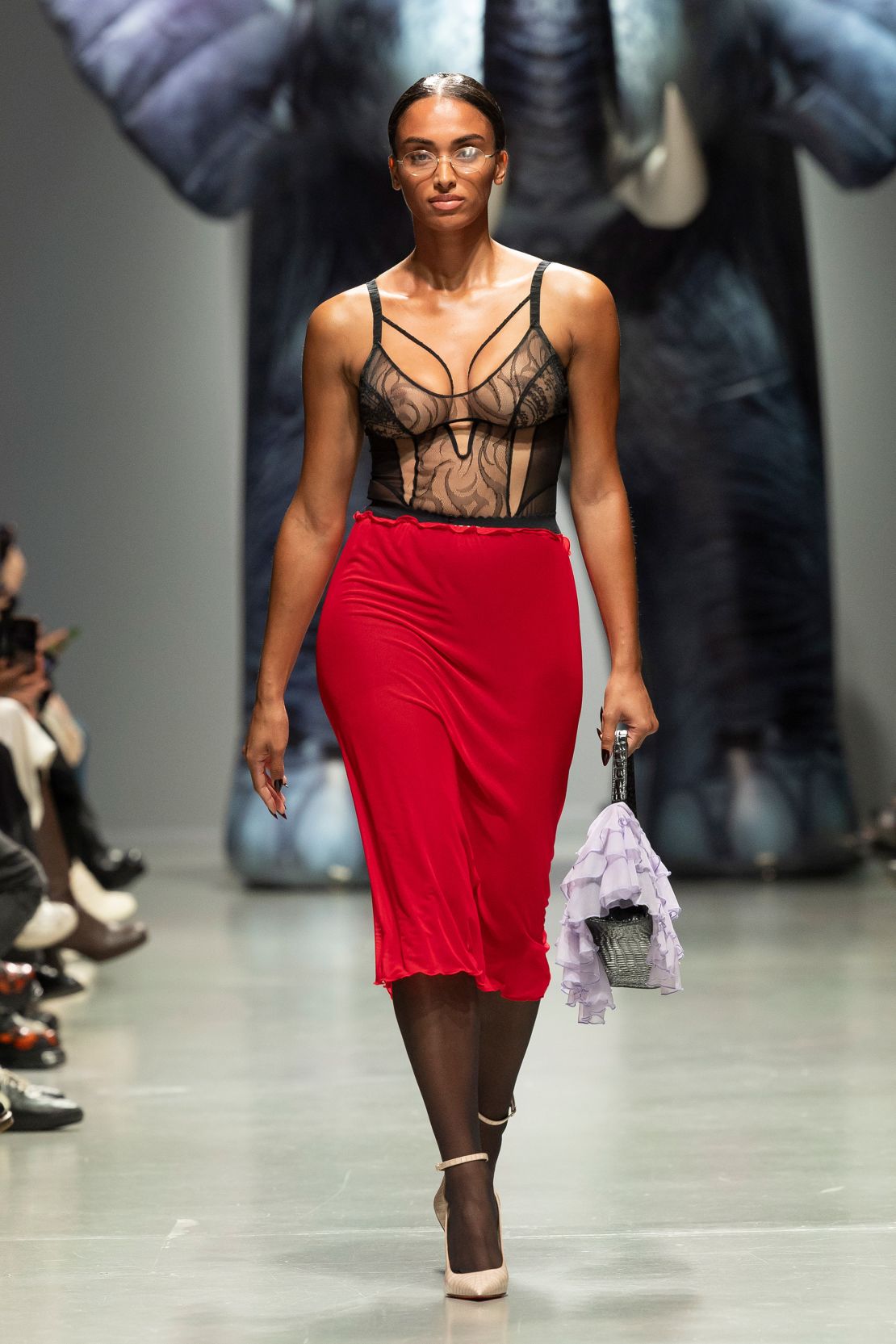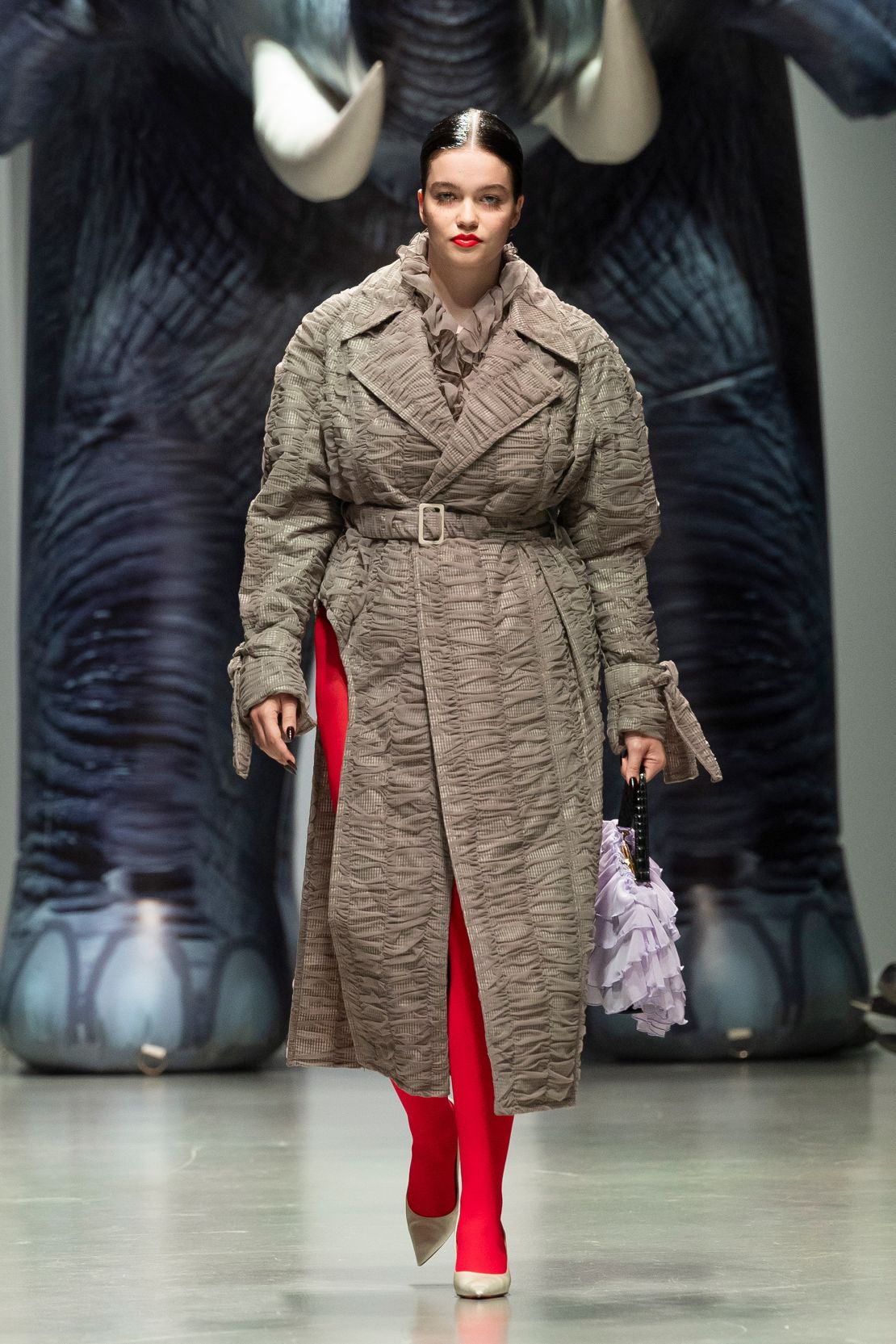Paris
CNN
—
On the second day of Paris Fashion Week at the city’s Palais de Tokyo, a giant inflatable elephant welcomed guests to the Ester Manas fashion show. The label (the only one on the official calendar dedicated solely to creating size-inclusive collections), cast a diverse range of bodies in a collection featuring finely crafted tulle, apparent lingerie and sanded, embossed leather.
Since its launch in 2019 by design duo and couple Ester Manas and Balthazar Delepierre, the house has been lauded for its use of adjustable couture techniques. Methods such as ruching and drawstrings eliminate the need for classical sizing and enable Ester Manas to cater to sizes XS to 3XL.
The label won the prestigious French fashion award the ANDAM prize in 2023 and has become a favorite for the likes of performers SZA, Jorja Smith, Kali Uchis and Beth Ditto, as well as representing a much-needed step away from the dominant ultra-thin ideals of the Parisian fashion scene.
But the aforementioned elephant in the room (which was also the title of the house’s show, and a decal emblazoned over tops) signposts a wider issue at play; one that was highlighted by the design duo backstage who say over the past few months there’s been less interest in — and less positive messaging around — embracing size inclusivity. “As a big person,” said Manas, “I notice ‘bienveillance’ (benevolence), has shifted… That everyday fatphobia has come back.”
It was a feeling which became more apparent, say the pair, in the days before the show, as they put the finishing touches to their collection.
“This season, we were given very few casting options for (size inclusive) models simply because overseas models don’t come (to Paris) for castings,” said Manas. “We are (now, one of) the only brands to give them work.”

The design duo also said model bookers asked them “how many normal models” they had booked for the show, meaning how many of a lower BMI. “The matter of what we call the ‘norm’ or ‘normal’ is what needs to be questioned, when skinny is something trained from a young age in France,” said the pair. “(Drinking water) to fill you up, smoking cigarettes to cut your appetite, cutting desert… It is constant, normalized (behavior).”
Backstage after the collection had been shown, the designers (who had included a comedic image of an “Ozempics” logo t-shirt on their mood board) told CNN of their shock at witnessing so many celebrities who had professed to be comfortable with their image suddenly shedding pounds over the past year. It’s a look the brand call “being Ozempicked.”
Diabetes medications such as Ozempic and Wegovy (also known as GLP-1 medications) have risen in popularity over the past two years due to their ability to help the user lose weight, so much so that investment banking company Goldman Sachs forecast the drugs could be used by up to 70 million consumers worldwide by 2028.
The knock-on effects of such widespread adoption on the fashion and beauty industry (not to mention society at large) are obvious and, if Ester Manas’s experience is representative, already being felt.

As reported by CNN last year, in 2023 fashion search engine Tagwalk found that the number of mid and plus-size models appearing at the Fall-Winter 2023 shows dropped by 24% in comparison to the Spring-Summer season. Similarly, a 2023 size inclusivity report conducted by Vogue Business found that 95.6% of all looks presented for Fall-Winter 2023 were in a size US 0-4.
Ester Manas themselves say they have found increasing difficulty selling in the wholesale market and are now increasingly turning to direct sales and a ‘See Now, Buy Now’ model whereby pieces are available for pre-order as soon as they’ve gone down the runway.
“Numerically, it is very apparent that this ‘trend’ (of both being personally comfortable with your size and size inclusivity being socially accepted) has retreated,” Delepierre said. The pair also cite questions from fashion journalists backstage enquiring how the brand would evolve now “the plus-sized trend” was waning.

“It’s not that fashion became inclusive but that inclusivity was in fashion,” explained Giulietta Canzani Mora, a publicist and TV host who is close to the brand. “It felt like the industry wanted to make a difference in the world, but it seems not to be the case. People just wanted to be assimilated into what’s cool, which (embracing size inclusivity) was for a while, not because it is for the greater good.”
Concerning, too, for the Ester Manas team is maintaining the visibility of “a generation of women (models, members of our community, activists involved in the brand) who were brought to the table through the seeming (cultural) shift (towards increased inclusivity). Where will they go now?”
Guillaume Boulez, a stylist who has dressed models, dancers and former athletes for Ester Manas has faith. “Beyond the size dimension, (Ester Manas clothes) are strong pieces that stand on their own and make everyone feel sexy,” he said. It’s what the brand sets out to do, for women of any size. “The women we dress are smart, lead great careers and dress the way they want,” said Delepierre. “We hope to bring them confidence and the choice to be visible, free.”










